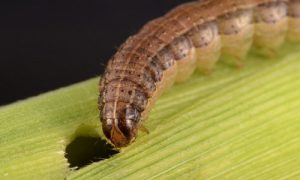 I appreciate you brining in a sample which made it much easier to identify. These are the eggs of the Fall armyworm, Spodoptera frugiperda. The number of eggs per mass varies considerably but is often 100 to 200, and total egg production per female averages about 1,500 with a maximum of over 2,000. Duration of the egg stage is only two to three days during the summer months.
I appreciate you brining in a sample which made it much easier to identify. These are the eggs of the Fall armyworm, Spodoptera frugiperda. The number of eggs per mass varies considerably but is often 100 to 200, and total egg production per female averages about 1,500 with a maximum of over 2,000. Duration of the egg stage is only two to three days during the summer months.
Young larvae are greenish with a black head. The face of the mature larva is also marked with a white inverted “Y.” Larvae tend to conceal themselves during the brightest time of the day. Duration of the larval stage tends to be about 14 days during the summer and 30 days during cool weather. Larval feeding occurs uniformly in groups over larger areas, rather than in patches.
Caterpillars first skeletonize the grass blades and later create bare spots in the lawn. This species seemingly displays a very wide host range, with over 80 plants recorded, but clearly prefers grasses.
Other crops sometimes injured are apple, grape, orange, peach, strawberry and several flowers. Weeds known to serve as hosts include bentgrass, crabgrass, Johnson grass, morning glory, nutsedge, pigweed, and sandspur. The predators of fall armyworm are general predators attacking many other caterpillars.
Among the predators noted as important are various ground beetles, striped earwig, the spined soldier bug, and the insidious flower bug. Vertebrates such as birds, skunks, and rodents also consume larvae and pupae readily. Hand removal of the eggs is possible but there is not chemical to control the egg stage. Treat at the first sign of damage for best results. Insecticides are more effective against younger caterpillars. Apply chemicals to lawns between May and June but do not over apply.
Please read the directions on the label. Please read more information from the UF/IFAS publication: Fall Armyworm by Dr. John Capinera. http://edis.ifas.ufl.edu/pdffiles/IN/IN25500.pdf
 0
0
